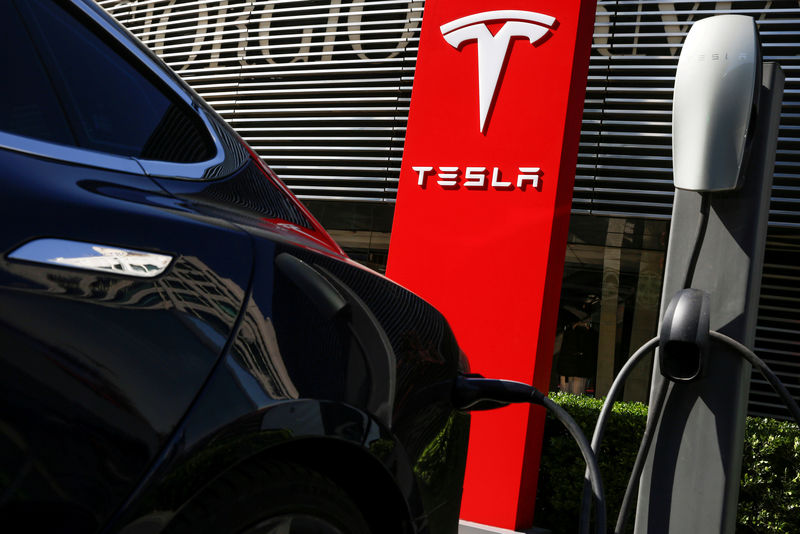By Alexandria Sage
SAN FRANCISCO (Reuters) - Investors are accustomed to the bold promises of Tesla Inc's (O:TSLA) Elon Musk, but his assertion that the electric vehicle maker will not need more funds this year has many scratching their heads. How can the chief executive deliver on his many goals without a fresh infusion of outside cash?
The California-based Tesla faces a crucial time in its 15-year history. Production setbacks with its new Model 3 - the hotly anticipated sedan Tesla vowed would push electric vehicles into the mainstream - have cast a shadow over Musk's promises and judgment. A host of new projects in the pipeline, from a semi truck to an SUV, now appear to some analysts as expensive, time-consuming distractions, even as rival automakers come to market with their own electric offerings.
A capital raise would raise alarm bells with investors as the company continues to burn money. Tesla reports first-quarter results on May 2.
Understanding Musk's bullish prediction is a complex accounting exercise that relies on multiple best-case scenarios. These include: building a promised 5,000 Model 3 sedans per week by the end of the second quarter; curtailing or deferring high spending that added up to $3.4 billion in capital expenditures in 2017; and improving gross margins.
The dearth of information about Tesla's multiple capital-intensive projects - from the Model Y crossover this year, the partially built battery Gigafactory in Nevada, and the Semi truck and Roadster, forecast to begin production in 2019 and 2020 - complicates the task.
"There are a lot of moving parts there," Andrew Walker of Rangeley Capital, which holds a small short position in Tesla, said on Wednesday. "It's just so many questions and such a black box, it's very difficult to determine going forward." Shorts bet that a share price will fall.
Tesla shares were up 1 percent at $283.67 on Thursday afternoon. Its shares have fallen over 9 percent so far this year.
UBS analyst Colin Langan has estimated that Tesla - which ended 2017 with $3.37 billion in cash - could fall below a cushion of $1 billion at the end of June due to estimated negative free cash flow of $1.6 billion in the first half of the year. Some, like Bernstein, put that estimate higher, at negative $1.8 billion.
Subtracting another $1.2 billion for 2018 debt refinancing and accrued liabilities reduces Tesla's cash level to $600 million, UBS calculates. Using a more bullish free cash flow model, such as Morgan Stanley's first-half estimate of negative $880 million, Tesla would still hover just above the cushion, at $1.3 billion.
"Tesla may not 'need' to raise funds, but many investors expect that the company will very much 'want' to," wrote Morgan Stanley's Adam Jonas in a note published last week.
Much hinges on efficient, volume production of the Model 3 along with tight spending control.
Tesla aims to build 3,000-4,000 Model 3s per week next month, up from more than 2,000 Model 3s today, and to increase production to 5,000 by the end of the second quarter.
Building 5,000 Model 3s per week priced at $44,000 would yield revenue of $2.64 billion per quarter, although efficiency determines how much of that trickles down to the bottom line.
But those calculations may be moot. Morgan Stanley's Jonas noted that "no investor that we have spoken to expects Model 3 production of 5k/week by the end of 2Q'18."
'LOSING CREDIBILITY'
Tesla has repeatedly underestimated its capital requirements and has raised money, whether through equity or debt, even after claiming it had no need to do so.
"The company's financial predictions may be losing credibility within the financial community," wrote Cowen & Co analyst Jeffrey Osborne in a note to clients earlier this month.
Since March, short interest in the stock has risen sharply to 30 percent of float, or shares available for trading.
Currently, analysts, on average, predict Tesla will not reach profitability on a non-GAAP basis until the first quarter of 2019. According to Thomson Reuters data, analysts see adjusted losses of $217.6 million and $40.1 million in the third and fourth quarters, respectively, after revising estimates downward to twice the losses they expected at the end of 2017.
They expect, on average, negative cash flow of $125 million and $67 million in the third and fourth quarters.
Other one-off factors influencing profit include the sale of zero emission vehicle (ZEV) credits or deposits from Model Y customers. Musk's recent admission that he erred in adding too much automation into the Model 3 assembly line could also prove an expensive mistake to unwind.
The Model 3 targets a 25 percent gross margin when fully ramped, but with production line stoppages and the need to hire 400 more hourly workers, the vehicle's negative margins today could be further pressured in the short-term.

With all that in mind, a 2018 capital raise, according to UBS's Langan, is "a question of when, not if."